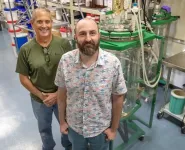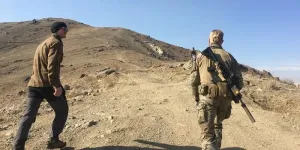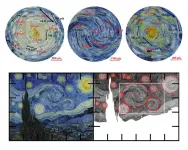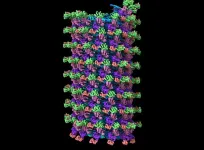(Press-News.org) SAN ANTONIO — September 17, 2024 —Southwest Research Institute (SwRI) is collaborating with The University of Texas at San Antonio (UTSA) to explore and develop a novel platform or chemical process for synthesizing antibiotic compounds with a $125,000 grant. The project, one of two winning proposals this cycle, is supported by the Connecting through Research Partnerships (Connect) program designed to foster collaboration between SwRI and UTSA.
“SwRI and UTSA will work together to combat the growing threat antimicrobial resistance poses to global health by developing a proof-of-concept platform to potentially create a whole library of new antibiotics,” said Dr. Shawn Blumberg, a lead scientist in SwRI’s Chemistry and Chemical Engineering Division and co-principal investigator (PI) of the project.
The World Health Organization (WHO) estimates antimicrobial resistance (AMR) is either a direct cause or a contributing factor in millions of deaths worldwide each year. The crisis is exacerbated by what WHO calls “an antibiotics pipeline and access crisis.”
Blumberg and his co-PI, Dr. Stanton F. McHardy of UTSA’s College of Sciences, will focus on creating a pipeline of new polycyclic antibiotics. This class of antibiotics includes tetracyclines, commonly used to treat pneumonia; anthracyclines, used to fight cancer; and polycyclic xanthones, natural compounds with known health benefits.
“Polycyclic xanthones offer a variety of potential therapeutic applications, but they haven't been assessed yet,” said McHardy. “With the new synthesis process, we’re hoping to rapidly access a unique class of chemical building blocks, structural analogs and new compounds.”
The team plans to use the process to discover more effective tetracycline antibiotics and safer anthracycline treatments with fewer side effects. Blumberg and McHardy also hope to create synthetic polycyclic xanthones that can mimic natural analogues while delivering new mechanisms of action, or new ways of fighting infections.
To achieve their goals, Blumberg and McHardy say they’ll tap into the unique reactivity of dendralenes, which are chemical compounds used to “glue” molecular fragments together in a single step. Their goal is to rapidly explore and discover new treatments while improving or finding new techniques to tweak the structure of existing antibiotics to improve safety, reverse resistance and combat AMR worldwide.
“I like to think of it as a relay race,” said Blumberg, “SwRI will procure and synthesize advanced starting materials to deliver to UTSA. Then Dr. McHardy and his team will screen those materials to identify optimal conditions for achieving our desired chemical outcome. With those findings, SwRI will begin to synthesize additional materials until the molecular fragments are stitched together as designed.”
The project will run through July of 2025.
For more information, visit https://www.swri.org/industries/pharmaceutical-development.
END
SwRI and UTSA will create synthetic process for antibiotic drug discovery
Researchers to develop unique chemical processes to combat antimicrobial resistance
2024-09-17
ELSE PRESS RELEASES FROM THIS DATE:
Norwegian Afghanistan veterans more prone to anger
2024-09-17
From 2001 to 2021, roughly 9200 Norwegian soldiers served in Afghanistan. The vast majority of them have managed well in the years that have followed. According to a new survey conducted by the Norwegian Armed Forces Joint Medical Services, however, a significant number of the veterans struggle with mental health issues.
“All Norwegian veterans who served in Afghanistan were invited to participate in a large health survey in 2020,” says Associate Professor Andreas Espetvedt Nordstrand at the Norwegian University of Science and Technology ...
Black hole pairs may unveil new particles
2024-09-17
In a paper published in Physical Review Letters this week, physicists from Amsterdam and Copenhagen argue that close observations of merging black hole pairs may unveil information about potential new particles. The research combines several new discoveries made by UvA scientists over the past six years.
Gravitational waves that are emitted by the merger of two black holes carry detailed information about the shape and evolution of the orbits of the components. A new study by physicists Giovanni Maria Tomaselli and Gianfranco Bertone from ...
Amsterdam UMC led research sets a step forward in the battle against MRSA
2024-09-17
Staphylococcus aureus, mostly known from its antibiotic-resistant variant Methicillin-resistant Staphylococcus aureus (MRSA), is among the leading causes of both community- and hospital-acquired infections. According to the most recent data, MRSA killed around 120,000 people in 2022 globally and far more are killed by antibiotic-susceptible strains of S. aureus. So far however, all attempts at developing a protective vaccine for S. aureus have been unsuccessful. Research from Amsterdam UMC, in collaboration with UMC Utrecht, Leiden University, and the University of California, San Diego, have discovered an important immune component that offers protection against infection, ...
Childhood trauma linked to major biological and health risks
2024-09-17
A new study led by UCLA Health found that a person’s sex and their unique experiences of childhood trauma can have specific consequences for their biological health and risk of developing 20 major diseases later in life.
Although a large body of research has shown that childhood adversity can have long-lasting impacts on a person’s biology and health, there has been little research looking into how different types of stressors affect specific biological functions and health risks.
The new findings, published in the journal ...
Beneath the brushstrokes, van Gogh’s sky is alive with real-world physics
2024-09-17
WASHINGTON, Sept. 17, 2024 – Vincent van Gogh’s painting “The Starry Night” depicts a swirling blue sky with yellow moon and stars. The sky is an explosion of colors and shapes, each star encapsulated in ripples of yellow, gleaming with light like reflections on water.
Van Gogh’s brushstrokes create an illusion of sky movement so convincing it led atmospheric scientists to wonder how closely it aligns with the physics of real skies. While the atmospheric motion in the painting cannot be measured, the brushstrokes can.
In an article published this week in Physics ...
Excess body weight and the risk of second primary cancers among cancer survivors
2024-09-17
About The Study: In this cohort study of older survivors of nonmetastatic cancer, those who had overweight or obesity at the time of their first cancer diagnosis were at higher risk of developing a second cancer, especially an obesity-related second cancer. Given the high prevalence of overweight and obesity among cancer survivors, it is important to promote survivorship care guidelines recommending weight management and increase awareness of second cancers among physicians and cancer survivors.
Corresponding author: To contact the corresponding author, Clara Bodelon, Ph.D., M.S., email clara.bodelon@cancer.org
To access the embargoed study: Visit our For The ...
Outcomes by race and ethnicity following a Medicare bundled payment program for joint replacement
2024-09-17
About The Study: This cohort study shows that the Comprehensive Care for Joint Replacement program outcomes differed by race and ethnicity for patients covered outside traditional Medicare, with home discharge rates increasing more for Hispanic compared with non-Hispanic white patients. These findings suggest the importance of considering differential outcomes of Medicare payment policies for racial and ethnic minority patient populations beyond the initially targeted groups.
Corresponding author: To contact the corresponding author, Narae Kim, Ph.D., ...
LJI discovery paves the way for antivirals against Ebola virus and its deadly relatives
2024-09-17
LA JOLLA, CA—At this moment, the world has few tools to combat deadly filoviruses, such as Ebola and Marburg viruses. The only approved vaccine and antibody treatments protect against just one filovirus species.
Scientists at La Jolla Institute for Immunology (LJI) are working to guide the development of new antivirals by leading some clever enemy reconnaissance. These researchers use high-resolution imaging techniques to examine a virus's molecular structure—and uncover where a virus is vulnerable to new therapies.
In a new Cell study, scientists in LJI's Center for Vaccine Innovation share the first ...
Advanced 3D mammography detects more breast cancers, fewer false positives
2024-09-17
New Haven, Conn. — The newer, 3D form of breast screening, known as digital breast tomosynthesis (DBT), is more effective at detecting breast cancer than traditional 2D digital mammography (DM). That’s the conclusion of an analysis of 13 years’ worth of screening data conducted by Yale Cancer Center researchers. The data also suggests that 3D mammograms could reduce the incidence of advanced cancer diagnoses.
“Most of the time, women will do better with 3D mammograms since their ...
How an MBA can empower entrepreneurs
2024-09-17
Many leading entrepreneurs have questioned the value of investing in an MBA if you want to run a successful start-up. But a recent survey conducted with members of the INSEAD community shows that going to business school can help ensure that any entrepreneurial scheme has a better chance of achieving greater impact and long-term success.
According to the INSEAD Alumni Entrepreneurship Report 2024, 73 percent of the INSEAD students and graduates surveyed embarked on entrepreneurial activities following their time at the global business school. More than ...
LAST 30 PRESS RELEASES:
Why nail-biting, procrastination and other self-sabotaging behaviors are rooted in survival instincts
Regional variations in mechanical properties of porcine leptomeninges
Artificial empathy in therapy and healthcare: advancements in interpersonal interaction technologies
Why some brains switch gears more efficiently than others
UVA’s Jundong Li wins ICDM’S 2025 Tao Li Award for data mining, machine learning
UVA’s low-power, high-performance computer power player Mircea Stan earns National Academy of Inventors fellowship
Not playing by the rules: USU researcher explores filamentous algae dynamics in rivers
Do our body clocks influence our risk of dementia?
Anthropologists offer new evidence of bipedalism in long-debated fossil discovery
Safer receipt paper from wood
Dosage-sensitive genes suggest no whole-genome duplications in ancestral angiosperm
First ancient human herpesvirus genomes document their deep history with humans
Why Some Bacteria Survive Antibiotics and How to Stop Them - New study reveals that bacteria can survive antibiotic treatment through two fundamentally different “shutdown modes”
UCLA study links scar healing to dangerous placenta condition
CHANGE-seq-BE finds off-target changes in the genome from base editors
The Journal of Nuclear Medicine Ahead-of-Print Tip Sheet: January 2, 2026
Delayed or absent first dose of measles, mumps, and rubella vaccination
Trends in US preterm birth rates by household income and race and ethnicity
Study identifies potential biomarker linked to progression and brain inflammation in multiple sclerosis
Many mothers in Norway do not show up for postnatal check-ups
Researchers want to find out why quick clay is so unstable
Superradiant spins show teamwork at the quantum scale
Cleveland Clinic Research links tumor bacteria to immunotherapy resistance in head and neck cancer
First Editorial of 2026: Resisting AI slop
Joint ground- and space-based observations reveal Saturn-mass rogue planet
Inheritable genetic variant offers protection against blood cancer risk and progression
Pigs settled Pacific islands alongside early human voyagers
A Coral reef’s daily pulse reshapes microbes in surrounding waters
EAST Tokamak experiments exceed plasma density limit, offering new approach to fusion ignition
Groundbreaking discovery reveals Africa’s oldest cremation pyre and complex ritual practices
[Press-News.org] SwRI and UTSA will create synthetic process for antibiotic drug discoveryResearchers to develop unique chemical processes to combat antimicrobial resistance






